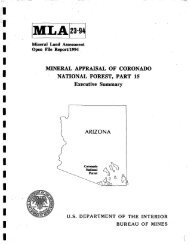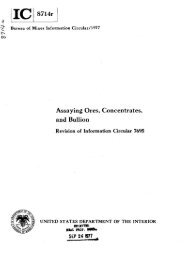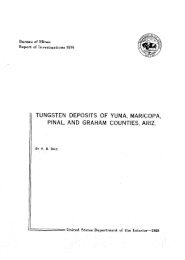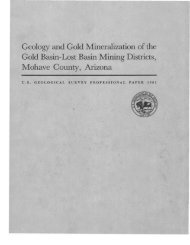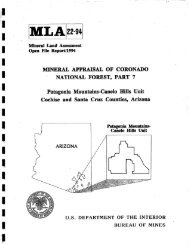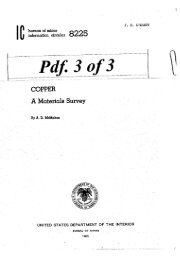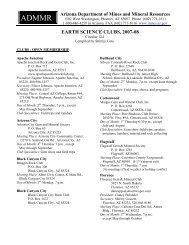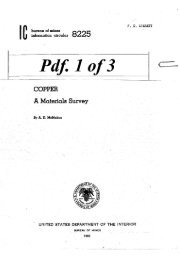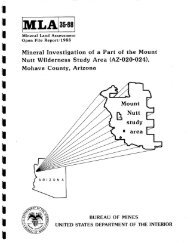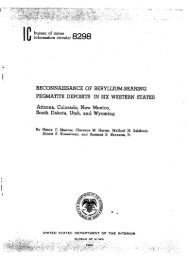here - State of Arizona Department of Mines and Mineral Resources
here - State of Arizona Department of Mines and Mineral Resources
here - State of Arizona Department of Mines and Mineral Resources
Create successful ePaper yourself
Turn your PDF publications into a flip-book with our unique Google optimized e-Paper software.
158 PRINCIPAL GOLD-PRODUCING DISTRICTS OF THE UNITED STATES<br />
Tertiary age caps the older rocks (Knopf, 1913,<br />
p. 80-85, <strong>and</strong> pI. 1).<br />
In the Remini-Tenmile district, two periods <strong>of</strong><br />
mineralization are recognizable: one <strong>of</strong> Late Cretaceous<br />
<strong>and</strong> one <strong>of</strong> late Tertiary age (Knopf, 1913,<br />
p. 81). The older <strong>and</strong> more productive ore bodies<br />
are auriferous silver-lead veins in tourmalinized<br />
<strong>and</strong> sericitized quartz monzonite in the upper part<br />
<strong>of</strong> the batholith. The principal ore mineral is galena<br />
accompanied by sphalerite, pyrite, arsenopyrite,<br />
<strong>and</strong> a little chalcopyrite <strong>and</strong> tetrahedrite; most <strong>of</strong><br />
the lodes are notably tourmaline-bearing. The Tertiary<br />
deposits are low grade <strong>and</strong> consist <strong>of</strong> altered<br />
rhyolite impregnated with gold along small fractures<br />
(Knopf, 1913, p. 82). The rhyolite rests unconformably<br />
on the eroded surface <strong>of</strong> the quartz<br />
monzonite.<br />
SEVENMILE-SCRATCHGRAVEL DISTRICT<br />
The Sevenmile-Scratchgravel district includes the<br />
Scratchgravel Hills which are about 4 miles northwest<br />
<strong>of</strong> Helena <strong>and</strong> immediately north <strong>of</strong> Sevenmile<br />
Creek. The ore deposits include gold placers, rich<br />
silver-lead veins, <strong>and</strong> gold veins (Pardee <strong>and</strong> Schrader,1933,p.35-62).<br />
Placer deposits were discovered in Iowa Gulch,<br />
in the northern part <strong>of</strong> the Scratchgravel Hills,<br />
shortly before gold was discovered in Last Chance<br />
Gulch at Helena in 1864. These deposits were not<br />
large, <strong>and</strong> t<strong>here</strong> has been little activity on them<br />
since the early days. The amount <strong>of</strong> gold produced<br />
is not known (Pardee <strong>and</strong> Schrader, 1933, p. 36).<br />
Other placer deposits along Sevenmile Creek <strong>and</strong><br />
its tributaries, including Greenhorn Creek, were<br />
considerably more productive.<br />
These creeks were mined for an aggregate length<br />
<strong>of</strong> 12 miles or more, <strong>and</strong> by 1930 yielded an estimated<br />
$1,200,000 (58,055 ounces) worth <strong>of</strong> gold<br />
(Pardee <strong>and</strong> Schrader, 1933, p. 59). From 1930<br />
through 1959 the yield probably was less than 750<br />
ounces (Lyden, 1948, p. 58-59).<br />
The lode deposits were discovered before 1872.<br />
Some rich silver-lead ore was mined in the early<br />
years, <strong>and</strong> in 1914 rich gold ore was found in the<br />
Franklin <strong>and</strong> Scratchgravel mines. The period<br />
1916-18 was one <strong>of</strong> great prosperity in which the<br />
lode mines, primarily the Franklin <strong>and</strong> Scratchgravel<br />
mines, produced at least $550,000 (26,600<br />
ounces) in gold. By 1919, however, costs <strong>of</strong> supplies<br />
<strong>and</strong> labor forced these mines to close, <strong>and</strong> lode<br />
production was then limited to desultory output <strong>of</strong><br />
several smaller mines. Total lode gold production<br />
<strong>of</strong> the district through 1959 was about 48.700<br />
ounces; total lode <strong>and</strong> placer production through<br />
1959 was at least 108,000 ounces.<br />
The country rock consists <strong>of</strong> shale, s<strong>and</strong>stone, <strong>and</strong><br />
limestone <strong>of</strong> the Belt Series <strong>of</strong> late Precambrian<br />
age <strong>and</strong> quartzite. shale. <strong>and</strong> limestone <strong>of</strong> Cambrian,<br />
Devonian, <strong>and</strong> Mississippian age. The bedd('q rocks<br />
are folded <strong>and</strong> are intruded by diorite anc' quartz<br />
monzonite, probably <strong>of</strong>fshoots <strong>of</strong> the Boulde- batholith,<br />
<strong>of</strong> Cretaceous or Tertiary age (Parnee <strong>and</strong><br />
Schrader, 1933, p. 36-37; 59).<br />
The ore deposits in the Scratchgravel Pills include<br />
contact-metamorphic deposits, gold veins, <strong>and</strong><br />
lead-silver veins. Most <strong>of</strong> the gold deposits E,re goldquartz<br />
veins in quartz monzonite. Pyrite is the most<br />
common ore mineral in the unoxidized ores., <strong>and</strong> in<br />
some veins t<strong>here</strong> are scattered grains <strong>and</strong> bunches<br />
<strong>of</strong> galena <strong>and</strong> a little sphalerite. Gold can be panned<br />
from the oxidized ore (Pardee <strong>and</strong> SchradElr, 1933,<br />
p.37-58).<br />
In the Sevenmile Creek area the lodes yielded<br />
chiefly silver, lead, copper, <strong>and</strong> gold. The lodes are<br />
irregular pockets or pipelike bodies in limestone<br />
near the quartz monzonite contact. Most <strong>of</strong> the ore<br />
was oxidized <strong>and</strong> the chief constituents were iron<br />
oxides, gold, silver-bearing galena, <strong>and</strong> copper carbonates.<br />
STEMPLE-VIRGINIA CREEK DISTRICT<br />
Located about 28 to 35 miles northwest <strong>of</strong> Helena<br />
in the drainage basin <strong>of</strong> Virginia Creek, the Stemple<br />
(Gould) -Virginia Creek district contained both<br />
placer <strong>and</strong> lode ore deposits. The lode ore was valued<br />
chiefly for gold; only about 5 percert <strong>of</strong> its<br />
value was silver (Lyden, 1948, p. 63). Mining began<br />
at least as early as 1878 when the HC"llestake<br />
lode in the Stemple area was located; in 1884 the<br />
Jay GOUld, the principal mine in the district. was<br />
discovered (Pardee <strong>and</strong> Schrader, 1933, p. 77, 86).<br />
These <strong>and</strong> other mines in the district were worked<br />
intermittently. Beginning in 1922 the Jav Gould<br />
mine operated almost continuously to 1942 when<br />
all minework was suspended. A small pr'lduction<br />
from the district was reported for the period<br />
1943-51.<br />
The gravels along Virginia Creek have been<br />
mined from Stemple to its mouth, a dis";ance <strong>of</strong><br />
about 8 miles. Their date <strong>of</strong> discovery has not been<br />
ascertained. The gravels were moderately rich but<br />
not very deep; prior to 1927 they yielded at least<br />
$600,000 (29,028 ounces) in gold (Pariee <strong>and</strong><br />
Schrader, 1933, p. 86). From 1927 to 19·i2 small<br />
intermittent production was reported (Lyden, 1948,<br />
p. 63), but it probably totaled less than 200 ounces.



